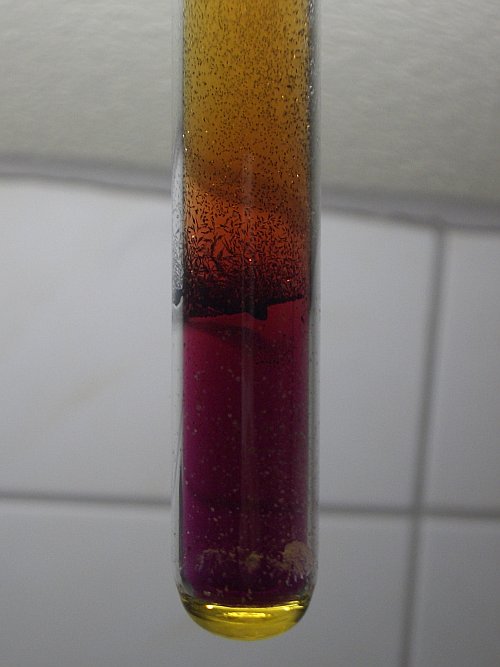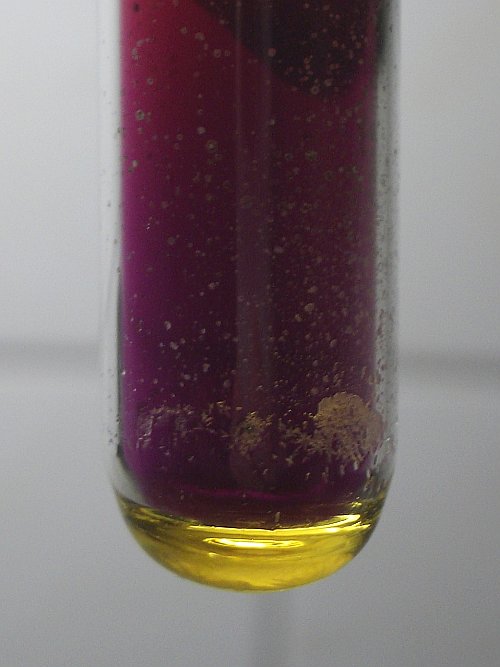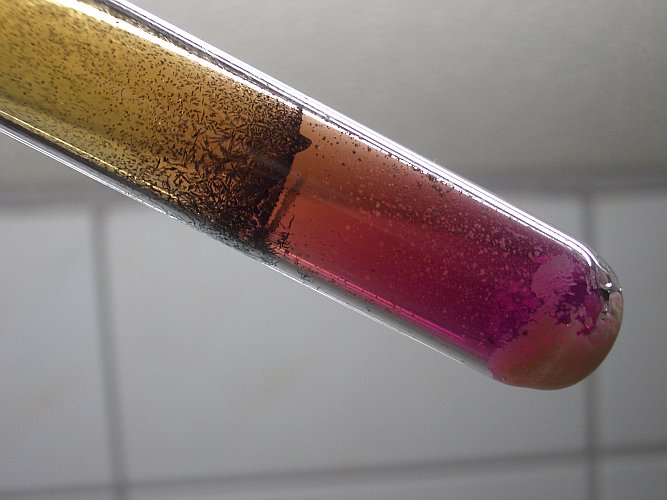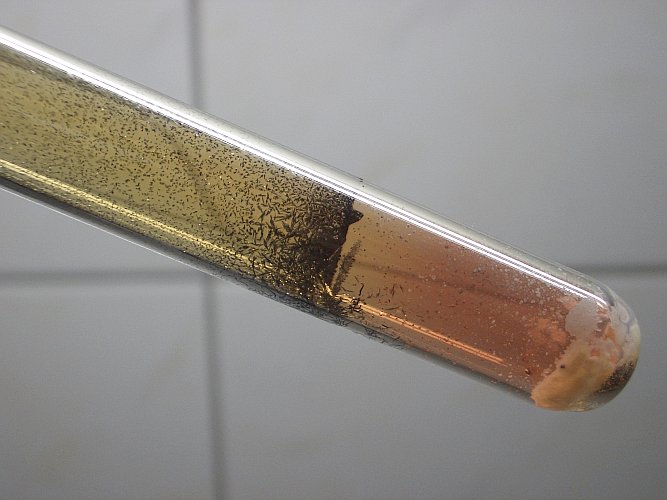


Reaction between nitrite and acid iodate
In this experiment it was tested how nitrite ion and iodate ion interact at high temperature. It is quite remarkable that under water-free conditions at high temperature, the nitrite and iodate react to form lots of iodine and nitrogen dioxide.
The experiment is beautiful to do on its own, the result is quite spectacular and a beautifully colored gas mix is produced in this experiment.
![]()
![]() Required
chemicals:
Required
chemicals:
-
potassium iodate, KIO3
-
potassium hydrogen iodate, KH(IO3)2
-
sodium nitrite, NaNO2
![]() Required
equipment:
Required
equipment:
-
test tube
-
means to heat the test tube
![]() Safety:
Safety:
-
Both potassium (hydrogen) iodate and sodium nitrite are oxidizers. Be careful with the molten mix, it is very reactive and may ignite in contact with any combustible material. Perform this experiment above a concrete tile, just in case the test tube cracks.
-
Iodine vapor and nitrogen dioxide are produced in small quantities in this experiment. Do this experiment in a well ventilated room, or even better, outside or in a fume hood.
![]() Disposal:
Disposal:
-
All waste first must be neutralized with some sodium sulfite, and then it can be flushed down the drain.
Remark: Instead of using KH(IO3)2 one can also use plain KIO3 and NaHSO4. The latter chemicals are easier to obtain.
![]()
Performing the experiment
![]() Put some potassium hydrogen iodate in a test tube, and gently
heat it, with constant swirling, preventing the melting of some of the solid.
When this is done, then water is given off, which condenses at the cooler parts
of the test tube. The compound decomposes, giving a mix of KIO3 and I2O5.
Heat the entire test tube, such that no liquid water remains on the wall of the
test tube. The reaction can be written as:
Put some potassium hydrogen iodate in a test tube, and gently
heat it, with constant swirling, preventing the melting of some of the solid.
When this is done, then water is given off, which condenses at the cooler parts
of the test tube. The compound decomposes, giving a mix of KIO3 and I2O5.
Heat the entire test tube, such that no liquid water remains on the wall of the
test tube. The reaction can be written as:
2KH(IO3)2 → 2KIO3 + I2O5 + H2O
![]() When no
more water is produced, then heat a little stronger. This causes the solid mass
to melt. A light yellow liquid is produced. If heating is not too strong, then
no iodine vapor is produced, the solid mass just melts.
When no
more water is produced, then heat a little stronger. This causes the solid mass
to melt. A light yellow liquid is produced. If heating is not too strong, then
no iodine vapor is produced, the solid mass just melts.
![]() Add some solid NaNO2 to the molten mass. The NaNO2
quickly dissolves in the molten mass and a yellow liquid is formed. This yellow liquid produces a thick dark purple/brown gas
mix. The gas mix is emitted from the surface of the
liquid, while the liquid itself only has a pale color. The lower part of the gas mix is more purple than the upper part. At the
lower (hotter) part of the test tube, the mix is iodine and nitrogen dioxide.
Higher up in the test tube, the iodine settles at the glass, and the nitrogen
dioxide remains behind. The color of the gas mix gradually goes from
purple/brown to plain brown. All effects, mentioned above, are nicely shown in
the pictures below. Most remarkable is the strong contrast between the color of
the liquid, and the color of the gas mix above it. It is really weird to see
such a light liquid emit such dark bubbles of gas.
Add some solid NaNO2 to the molten mass. The NaNO2
quickly dissolves in the molten mass and a yellow liquid is formed. This yellow liquid produces a thick dark purple/brown gas
mix. The gas mix is emitted from the surface of the
liquid, while the liquid itself only has a pale color. The lower part of the gas mix is more purple than the upper part. At the
lower (hotter) part of the test tube, the mix is iodine and nitrogen dioxide.
Higher up in the test tube, the iodine settles at the glass, and the nitrogen
dioxide remains behind. The color of the gas mix gradually goes from
purple/brown to plain brown. All effects, mentioned above, are nicely shown in
the pictures below. Most remarkable is the strong contrast between the color of
the liquid, and the color of the gas mix above it. It is really weird to see
such a light liquid emit such dark bubbles of gas.


On cooling down, the test tube becomes very beautiful. The gas mix becomes beautifully red, the yellow liquid solidifies to a white solid. Nice feather-like crystals of iodine settle at the glass.

The result on further cooling down still is very nice. Especially the color of the gas mix near the bottom of the test tube is quite nice and unusual. At this stage, on can touch the test tube, without getting burnt, but it still feels quite hot.

![]()
A reference experiment with normal iodate
In this reference experiment it is investigated what happens if normal KIO3 is mixed with NaNO2. When that is done, and the mix is heated, then no iodine and nitrogen dioxide are formed. So, the acid in the KH(IO3)2 is essential in the experiment. Without acid, nitrite and iodate do not react. Not in aqueous solution, nor in the molten mix.
![]()
Explanation of results
A precise description of this reaction is hard to give. Many reactions occur at the same time. As mentioned above, the acid is essential in the reaction. Expected products in the reaction:
-
Oxidation product of nitrite: NO2
-
Reduction product of iodate, and decomposition product of iodate: I2
-
Decomposition product of iodate: O2
-
Oxidation product of nitrite: NaNO3
The extra acid allows for formation of normal iodate and no basic salts are formed in the reaction. Alkaline conditions inhibit the oxidation of the nitrite.